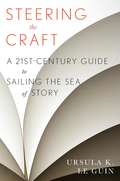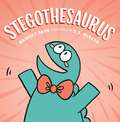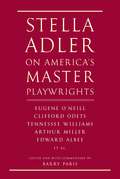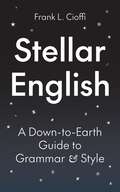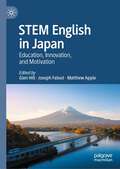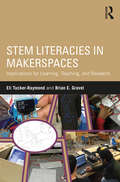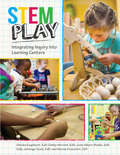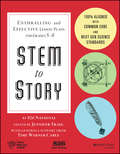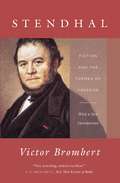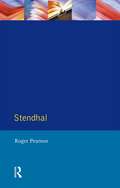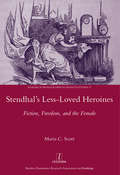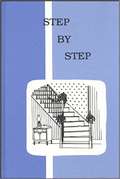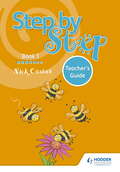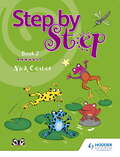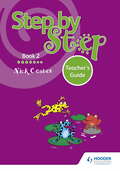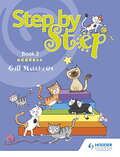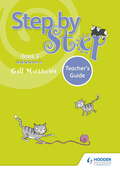- Table View
- List View
Steering the Craft: A Twenty-First-Century Guide to Sailing the Sea of Story
by Ursula K. Le GuinA revised and updated guide to the essentials of a writer's craft, presented by a brilliant practitioner of the art Completely revised and rewritten to address the challenges and opportunities of the modern era, this handbook is a short, deceptively simple guide to the craft of writing. Le Guin lays out ten chapters that address the most fundamental components of narrative, from the sound of language to sentence construction to point of view. Each chapter combines illustrative examples from the global canon with Le Guin's own witty commentary and an exercise that the writer can do solo or in a group. She also offers a comprehensive guide to working in writing groups, both actual and online. Masterly and concise, Steering the Craft deserves a place on every writer's shelf.
Steganography in Digital Media
by Jessica FridrichSteganography, the art of hiding of information in apparently innocuous objects or images, is a field with a rich heritage, and an area of rapid current development. This clear, self-contained guide shows you how to understand the building blocks of covert communication in digital media files and how to apply the techniques in practice, including those of steganalysis, the detection of steganography. Assuming only a basic knowledge in calculus and statistics, the book blends the various strands of steganography, including information theory, coding, signal estimation and detection, and statistical signal processing. Experiments on real media files demonstrate the performance of the techniques in real life, and most techniques are supplied with pseudo-code, making it easy to implement the algorithms. The book is ideal for students taking courses on steganography and information hiding, and is also a useful reference for engineers and practitioners working in media security and information assurance.
Stegothesaurus
by Bridget HeosA fun, playful, energetic story starring two stegosauruses and one stegothesaurus about family—and synonyms!—for the young word lover in your home, residence, or abode!Stegothesaurus’s love of language has always put him at odds with his stegosaurus brothers. So when he makes a friend—an allothesaurus—who is just as verbose as he, he is happy, thrilled, and ecstatic! But Stegothesaurus soon learns that the allothesaurus has very different ideas about what constitutes a good meal, and he'll discover there’s one thing that he loves more than words: his family. Featuring clever but simple text from Bridget Heos and bold, exuberant art by T. L. McBeth, Stegothesaurus introduces young readers to a memorable, original, unforgettable dinosaur hero.
Stella Adler on America's Master Playwrights: Eugene O'Neill, Thornton Wilder, Clifford Odets, William Saroyan, Tennessee Williams, William Inge, Arthur Miller, Edward Albee
by Stella AdlerIn her long-awaited book, the legendary acting teacher Stella Adler gives us her extraordinary insights into the work of Henrik Ibsen ("The creation of the modern theater took a genius like Ibsen . . . Miller and Odets, Inge and O'Neill, Williams and Shaw, swallowed the whole of him"), August Strindberg ("He understood and predicted the forces that would break in our lives"), and Anton Chekhov ("Chekhov doesn't want a play, he wants what happened in life. In life, people don't usually kill each other. They talk"). Through the plays of these masters, Adler discusses the arts of playwriting and script interpretation ("There are two aspects of the theater. One belongs to the author and the other to the actor. The actor thinks it all belongs to the author . . . The curtain goes up and all he knows are the lines . . . It is not enough . . . Script interpretation is your profession"). She looks into aspects of society and class, and into our cultural past, as well as the evolution of the modern spirit ("The actor learns from Ibsen what is modern in the modern theater. There are no villains, no heroes. Ibsen understands, more than anything, there is more than one truth"). Stella Adler--daughter of Jacob Adler, who was universally acknowledged to be the greatest actor of the Yiddish theater, and herself a disciple of Stanislavsky--examines the role of the actor and brings to life the plays from which all modern theater derives: Ibsen's Hedda Gabler, The Master Builder, An Enemy of the People, and A Doll's House; Strindberg's Miss Julie and The Father; Chekhov's The Seagull, Uncle Vanya, The Cherry Orchard, and Three Sisters ("Masha is the sister who is the mystery. You cannot reach her. You cannot reach the artist. There is no logical way. Keep her in a special pocket of feelings that are complex and different"). Adler discusses the ideas behind these plays and explores the world of the playwrights and the history--both familial and cultural--that informed their work. She illumines not only the dramatic essence of each play but its subtext as well, continually asking questions that deepen one's understanding of the work and of the human spirit. Adler's book, brilliantly edited by Barry Paris, puts her famous lectures into print for the first time.
Stellar English: A Down-to-Earth Guide to Grammar and Style (Skills for Scholars)
by Frank L. CioffiAn indispensable guide to essential principles of English grammar and usageStellar English lays out the fundamentals of effective writing, from word choice and punctuation to parts of speech and common errors. Frank Cioffi emphasizes how formal written English—though only a subdialect of the language—enables writers to reach a wide and heterogenous audience.Cioffi&’s many example sentences illustrating grammatical principles tilt in an otherworldly direction, making up a science fiction story involving alien invasion. Reading the book through will not only help you with your grammar but also reveal how the story ends!An invaluable brief handbook for native and nonnative speakers alike, Stellar English avoids the jargon and emphasis on outdated rules found in typical grammar guides and shows how good writing uses carefully constructed language that&’s at once appropriate to an audience and communicates—without distractions or confusion—just what the writer wants.
Stem Cells and Human Diseases
by Rakesh K. Srivastava Sharmila ShankarThe main objective of this book is to provide a comprehensive review on stem cells and their role in tissue regeneration, homeostasis and therapy. In addition, the role of cancer stem cells in cancer initiation, progression and drug resistance are discussed. The cell signaling pathways and microRNA regulating stem cell self-renewal, tissue homeostasis and drug resistance are also mentioned. Overall, these reviews will provide a new understanding of the influence of stem cells in tissue regeneration, disease regulation, therapy and drug resistance in several human diseases.
STEM English in Japan: Education, Innovation, and Motivation
by Glen Hill Joseph Falout Matthew AppleThis book focuses on Japanese science, technology, engineering and mathematics (STEM) students and their experiences of learning English. Students majoring in STEM face unique circumstances regarding their English language education. Despite the global use of English in these fields, the authors argue that Japanese STEM students fail to take advantage of coursework, extracurricular materials, teachers, peers, and other resources to raise their communicative abilities to a sufficient level for the workplace. This book offers insights into how STEM students can learn English more effectively and purposefully. The chapters provide firsthand perspectives into the psychologies, educational programs, and future workplace situations of Japanese STEM students, who are the innovators, inventors, and researchers of the future. This book will appeal to applied linguists and language teachers wherever STEM English is taught.
STEM Literacies in Makerspaces: Implications for Learning, Teaching, and Research
by Eli Tucker-Raymond Brian E. GravelProviding an original framework for the study of makerspaces in a literacy context, this book bridges the scholarship of literacy studies and STEM and offers a window into the practices that makers learn and interact with. Tucker-Raymond and Gravel define and illustrate five key STEM literacies—identifying, organizing, and integrating information; creating and traversing representations; communicating with others for help and feedback during making; documenting processes; and communicating finished products—and demonstrate how these literacies intersect with making communities. Through careful observation and analysis of multiple case studies, the authors highlight the impact of research and practice to support teaching and making in a variety of environments. Using a nuanced, engaging framework, they examine the necessary skills required to develop and foster makerspaces in formal and informal contexts for all students. Grounded in cutting-edge research, this volume paves the way for future study on supporting making and literacies in STEM.
STEM Play: Integrating Inquiry into Learning Centers
by Deirdre Englehart Debby Mitchell Junie Albers-Biddle Kelly Jennings-Towle Marnie ForestieriMost early childhood teachers are using learning centers in the classroom, but do not approach them in ways that fully support a variety of learning opportunities. This book approaches learning centers through the STEM (science, technology, engineering, math) lens, and shares how themes can be integrated into centers to promote creativity and higher-level thinking. STEM Play provides varied activities for the most common centers: Art, blocks, dramatic play, literacy, math, science, music and movement. Full of beautiful, full-color photos that show the activities in real early childhood classrooms, teachers can easily use the book’s ideas immediately in their curriculum. STEM Play also includes a “How To” section for teachers who wish to expand on the STEM focus and use themed activities in their learning centers.
STEM to Story
by 826 NationalBring STEM to life for students with zombies, rockets, celebrities, and moreSTEM to Story: Enthralling and Effective Lesson Plans for Grades 5-8 inspires learning through fun, engaging, and meaningful lesson plans that fuse hands-on discovery in science, technology, engineering, and math (STEM) with creative writing. The workshop activities within the book are the innovative result of a partnership between 826 National's proven creative writing model and Time Warner Cable's Connect a Million Minds, an initiative dedicated to connecting young people to the wonders of STEM through hands-on learning. Authentically aligned with both the Common Core State Standards and the Next Generation Science Standards, this book provides teachers, after-school and out-of-school providers, and parents with field-tested lessons, workshops, and projects designed by professionals in each field. Including reflective observations by arts and science celebrities like Jon Scieszka, Mayim Bialik, and Steve Hockensmith, lessons feature bonus activities, fun facts, and teaching points for instructors at every level. These quirky, exploratory lessons will effectively awaken student imaginations and passions for both STEM and creative writing, encourage identity with scientific endeavors, and make both science and writing fun.Grades five through eight is the critical period for engaging students in STEM, and this book is designed specifically to appeal to - and engage - this age group. The guided curricula fosters hands-on discovery, deep learning, and rich inquiry skills while feeling more like play than school, and has proven popular and effective with both students and teachers.Awaken student imagination and get them excited about STEMFuse creative writing with STEM using hands-on activitiesMake scientific principles relevant to students' livesInspire students to explore STEM topics furtherThe demand for STEM workers is closely linked to global competitiveness, and a successful future in STEM depends upon an early introduction to the scientific mindset. The challenge for teachers is to break through students' preconceptions of STEM fields as "hard" or "boring," to show them that STEM is everywhere, it's relevant, and it's loads of fun. For proven lesson plans with just a dash of weird, STEM to Story is a dynamic resource, adaptable and applicable in school, after school, and at home.
STEMscopes™ Texas: Science Literacy, [Grade] 3, English
by Accelerate Learning Inc. Rice UniversityNIMAC-sourced textbook
STEMscopes™ Texas: Science Literacy, [Grade] 4, English
by Accelerate Learning Inc. Rice UniversityNIMAC-sourced textbook
Stendhal: Fiction and the Themes of Freedom
by Victor BrombertVictor Brombert is a lion in the study of French literature, and in this classic of literary criticism, he turns his clear and perspicacious gaze on the works of one of its greatest authors—Stendhal. Best remembered for his novels The Red and the Black and The Charterhouse of Parma, Stendhal is a writer of extraordinary insight into psychology and the many shades of individual and political liberty. Brombert has spent a lifetime reading and teaching Stendhal and here, by focusing on the seemingly contradictory themes of inner freedom and outer constraint within Stendhal’s writings, he offers a revealing analysis of both his work and his life. For Brombert, Stendhal’s work is deeply personal; elsewhere, he has written about the myriad connections between Stendhal’s ironic inquiries into identity and his own boyhood in France on the brink of World War II. Proceeding via careful and nuanced readings of passages from Stendhal’s fiction and autobiography, Brombert pays particular attention to style, tone, and meaning. Paradoxically, Stendhal’s heroes often feel most free when in prison, and in a statement of stunning relevance for our contemporary world, Brombert contends that Stendhal is far clearer than any writer before him on the “crisis and contradictions of modern humanism that . . . render political freedom illusory.” Featuring a new introduction in which Brombert explores his earliest encounters with Stendhal—the beginnings of his “affair” during a year spent as a Fulbright scholar in Rome—Stendhal remains a spirited, elegant, and resonant account.
Stendhal: "The Red and the Black" and "The Charterhouse of Parma" (Modern Literatures In Perspective)
by Roger PearsonBoth critic and writer, Stendhal has now become established as one of realism's founding fathers. Dr Pearson's book maps out, for the first time, the critical reception of Stendhal's two most widely read novels, The Red and the Black and The Charterhouse of Parma since their publication in 1830 and 1839 respectively. In part one he provides generous samples of the most important nineteenth-century responses to the novels, almost all of them translated into English for the first time. Part two presents a full range of the most authoritative and influential readings since 1945, which illustrate a wide variety of critical approaches.
Stendhal's Less-Loved Heroines: Fiction, Freedom, and the Female
by Maria C. Scott"Stendhal's most independent heroines are usually disliked or marginalized by critics. However, when gender-neutral criteria are applied, Mina de Vanghel, Vanina Vanini, Mathilde de La Mole, and Lamiel can all be shown to enact extraordinary experiments in freedom. These experiments are all the more remarkable in view of the gender of their agents, the historical situation of the author (1783-1842), and the conventions of the literary movement that his fiction helped to found: realism. Simone de Beauvoir's 1949 study of Stendhal's heroines gives preference to the reserved females over his Amazons. But existentialism, as a philosophy of freedom, also enables a reading of the self-determining heroines that acknowledges the superiority of their choices: their resistance and counter-plots, their paradoxical authenticity, their rejection of seriousness, and their assumption of responsibility for the routes they plot."
Step By Step: Reading Textbook (Grade 6)
by LaGrange AylmerAll stories not otherwise credited have been written as text for this reader by the editors.
Step by Step Book 1 Teacher's Guide
by Nick CoatesAll you need to encourage a love and enthusiasm for reading and writing from a young age. Benefit from the experience of key educators across the Caribbean regions who have carefully designed this resource to give your students exactly the right introduction to the Language Arts curriculum.-Ensure a steady transition from Creole to Standard English with an introductory section on language acquisition in the Teacher Guides called Language Strategy. -Cover technicality of grammar, vocabulary and syntax using picture cues and writing as well as reading and reading comprehension. -Offer exposure to many different forms of text with a variety of different text types and genres. -Connect reading and writing with templates, to make sure that students don't fall behind and progress evenly with both. This book accompanies the Step by Step Student's Book 1, 9781510414150.
Step by Step Book 1 Teacher's Guide
by Nick CoatesAll you need to encourage a love and enthusiasm for reading and writing from a young age. Benefit from the experience of key educators across the Caribbean regions who have carefully designed this resource to give your students exactly the right introduction to the Language Arts curriculum.-Ensure a steady transition from Creole to Standard English with an introductory section on language acquisition in the Teacher Guides called Language Strategy. -Cover technicality of grammar, vocabulary and syntax using picture cues and writing as well as reading and reading comprehension. -Offer exposure to many different forms of text with a variety of different text types and genres. -Connect reading and writing with templates, to make sure that students don't fall behind and progress evenly with both. This book accompanies the Step by Step Student's Book 1, 9781510414150.
Step by Step Book 2
by Nick CoatesAll you need to encourage a love and enthusiasm for reading and writing from a young age. Benefit from the experience of key educators across the Caribbean regions who have carefully designed this resource to give your students exactly the right introduction to the Language Arts curriculum.-Ensure a steady transition from Creole to Standard English with an introductory section on language acquisition in the Teacher Guides called Language Strategy. -Cover technicality of grammar, vocabulary and syntax using picture cues and writing as well as reading and reading comprehension. -Offer exposure to many different forms of text with a variety of different text types and genres. -Connect reading and writing with templates, to make sure that students don't fall behind and progress evenly with both. Support for this student book is available from the accompanying Teacher's Guide 9781510414235.
Step by Step Book 2
by Nick CoatesAll you need to encourage a love and enthusiasm for reading and writing from a young age. Benefit from the experience of key educators across the Caribbean regions who have carefully designed this resource to give your students exactly the right introduction to the Language Arts curriculum.-Ensure a steady transition from Creole to Standard English with an introductory section on language acquisition in the Teacher Guides called Language Strategy. -Cover technicality of grammar, vocabulary and syntax using picture cues and writing as well as reading and reading comprehension. -Offer exposure to many different forms of text with a variety of different text types and genres. -Connect reading and writing with templates, to make sure that students don't fall behind and progress evenly with both. Support for this student book is available from the accompanying Teacher's Guide 9781510414235.
Step by Step Book 2 Teacher's Guide
by Nick CoatesAll you need to encourage a love and enthusiasm for reading and writing from a young age. Benefit from the experience of key educators across the Caribbean regions who have carefully designed this resource to give your students exactly the right introduction to the Language Arts curriculum.-Ensure a steady transition from Creole to Standard English with an introductory section on language acquisition in the Teacher Guides called Language Strategy. -Cover technicality of grammar, vocabulary and syntax using picture cues and writing as well as reading and reading comprehension. -Offer exposure to many different forms of text with a variety of different text types and genres. -Connect reading and writing with templates, to make sure that students don't fall behind and progress evenly with both. This book accompanies the Step by Step Student's Book 2, 9781510414167.
Step by Step Book 2 Teacher's Guide
by Nick CoatesAll you need to encourage a love and enthusiasm for reading and writing from a young age. Benefit from the experience of key educators across the Caribbean regions who have carefully designed this resource to give your students exactly the right introduction to the Language Arts curriculum.-Ensure a steady transition from Creole to Standard English with an introductory section on language acquisition in the Teacher Guides called Language Strategy. -Cover technicality of grammar, vocabulary and syntax using picture cues and writing as well as reading and reading comprehension. -Offer exposure to many different forms of text with a variety of different text types and genres. -Connect reading and writing with templates, to make sure that students don't fall behind and progress evenly with both. This book accompanies the Step by Step Student's Book 2, 9781510414167.
Step by Step Book 3
by Gill MatthewsAll you need to encourage a love and enthusiasm for reading and writing from a young age. Benefit from the experience of key educators across the Caribbean regions who have carefully designed this resource to give your students exactly the right introduction to the Language Arts curriculum.-Ensure a steady transition from Creole to Standard English with an introductory section on language acquisition in the Teacher Guides called Language Strategy. -Cover technicality of grammar, vocabulary and syntax using picture cues and writing as well as reading and reading comprehension. -Offer exposure to many different forms of text with a variety of different text types and genres. -Connect reading and writing with templates, to make sure that students don't fall behind and progress evenly with both. Support for this student book is available from the accompanying Teacher's Guide 9781510414242.
Step by Step Book 3
by Gill MatthewsAll you need to encourage a love and enthusiasm for reading and writing from a young age. Benefit from the experience of key educators across the Caribbean regions who have carefully designed this resource to give your students exactly the right introduction to the Language Arts curriculum.-Ensure a steady transition from Creole to Standard English with an introductory section on language acquisition in the Teacher Guides called Language Strategy. -Cover technicality of grammar, vocabulary and syntax using picture cues and writing as well as reading and reading comprehension. -Offer exposure to many different forms of text with a variety of different text types and genres. -Connect reading and writing with templates, to make sure that students don't fall behind and progress evenly with both. Support for this student book is available from the accompanying Teacher's Guide 9781510414242.
Step by Step Book 3 Teacher's Guide
by Gill MatthewsAll you need to encourage a love and enthusiasm for reading and writing from a young age. Benefit from the experience of key educators across the Caribbean regions who have carefully designed this resource to give your students exactly the right introduction to the Language Arts curriculum.-Ensure a steady transition from Creole to Standard English with an introductory section on language acquisition in the Teacher Guides called Language Strategy. -Cover technicality of grammar, vocabulary and syntax using picture cues and writing as well as reading and reading comprehension. -Offer exposure to many different forms of text with a variety of different text types and genres. -Connect reading and writing with templates, to make sure that students don't fall behind and progress evenly with both. This book accompanies the Step by Step Student's Book 3, 9781510414174.
